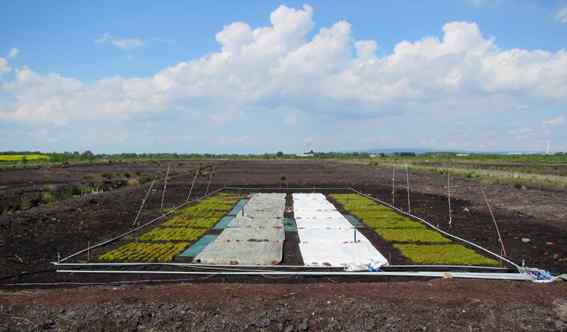Images of climate innovation
Growing Sphagnum to replace peat
UK lowland peatlands are badly degraded through drainage and harvesting, and release huge amounts of carbon dioxide, contributing significantly to global warming.
The Sphagnum Farming UK project tested methods of growing Sphagnum moss under a range of protective covers and irrigation regimes.
Growing Sphagnum to replace peat in horticulture will retain current carbon stocks, reduce carbon emissions, and produce an economic crop for farmers, protecting the planet and rural livelihoods.

Peat forms in wet, acidic conditions where dead plant material slowly decomposes and accumulates over thousands of years in deep layers of dense organic material, retaining the carbon sequestered during plant growth, and making peatlands the largest carbon store of any terrestrial habitat. Peatland degradation, through drainage for agriculture, forestry, urbanisation, and particularly through peat harvesting, oxidises the stored carbon and releases carbon dioxide, making peatlands sources rather than sinks for greenhouse gases. Peatland reclamation and restoration are essential tools in climate mitigation strategies. Sphagnum mosses are the main peat-forming plants in the Northern hemisphere and Sphagnum farming is a method of re-wetting peatlands, retaining carbon stocks, while delivering an economic return for farmers.
This picture of green oases in a desert of bare peat shows the first UK trials of growing a Sphagnum crop. The Sphagnum Farming UK project, funded by Innovate UK, was a partnership between BeadaMoss®, Melcourt Industries Ltd, Natural England, Manchester Metropolitan University and the University of East London. The project grew Sphagnum under a range of cover treatments and solar-powered irrigation regimes to test methods for optimising growth and upscaling potential, and trialled the product in growing media.
Peat-free compost currently uses coir and wood as substitutes but both come at an environmental cost. We found that Sphagnum moss is a highly suitable alternative, being the raw ingredient of peat without waiting several thousand years for it to form!
Our research generated knowledge and skills needed for upscaling from trial plots to field application, further development of BeadaMoss® Sphagnum, and processing of the material to create a quality growing media. The eventual goal is to halt the need to drain and extract peat, to produce a sustainable alternative and to create a new crop for farmers.
Entrant: Anna Keightley , Manchester Metropolitan University
Copyright: Anna Keightley
Funding: Innovate UK
Collaborators: Simon Caporn and Chris Field (Manchester Metropolitan University); Richard Lindsay and Jack Clough (University of East London); Paul Thomas (Natural England); BeadaMoss® (Micropropagation Services Ltd); Catherine Dawson (Melcourt Industries); Lancashire Wildlife Trust.